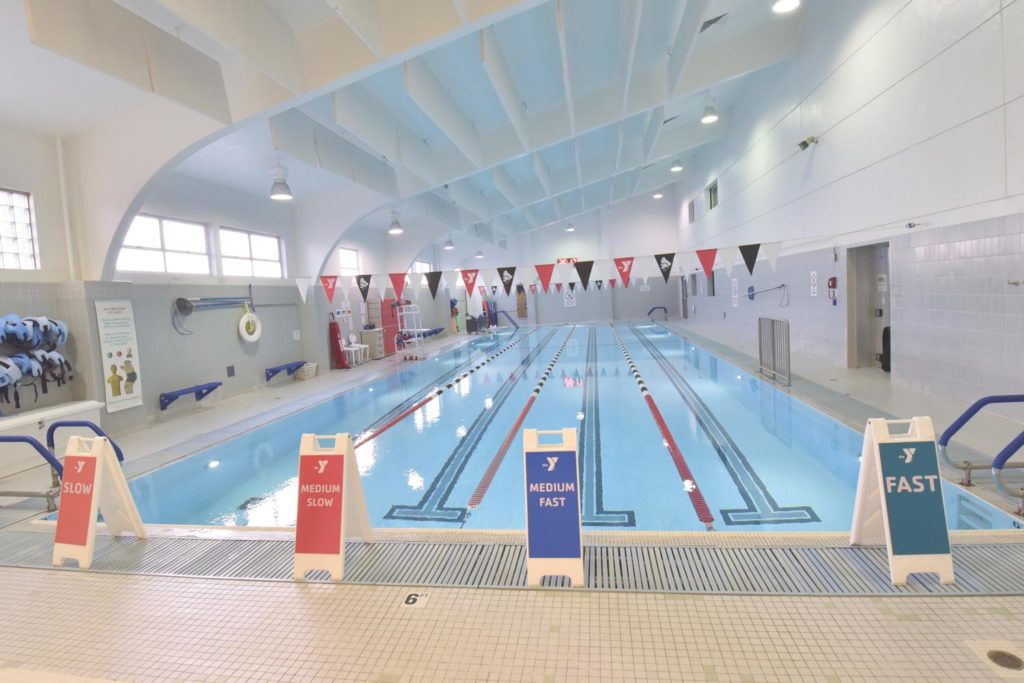Cleanliness and basic upkeep are critical factors in the member experience, especially as it pertains to aquatics amenities — no one wants to swim in a dirty pool. Without a regular schedule of pool maintenance and servicing, your pool will become filthy or, even worse, sustain significant damage.
“If you don’t keep up with maintenance, various systems can break down and shut down the pool,” said Beth Costello, the regional senior aquatics director at the Decatur Family YMCA. “This will negatively affect your members.”
At the Stonestown Family YMCA, a branch of the YMCA of San Francisco, the pools are a popular destination, so keeping the aquatics facility in good shape is a top priority.
“We have an average of 1,600 people using our facility per day, with approximately one-third of them using the pool — this is even higher on youth swimming lesson days,” said Lauren Clapperton, the branch’s associate executive director. “So we continually keep an eye on supplies, and replace them every two to three years, on average.”
With such high usage rates, Clapperton has seen the importance of aquatics to many members and keeping those services operating correctly. “The maintenance and functionality of aquatics equipment directly impacts the member experience,” she said. “We know to so many, the pool is the only space where they can experience non-impact physical activity, which is an essential part of the routine for swimmers, those with chronic pain and arthritis, or those recovering from injuries.”
Your pools are just like any piece of equipment — something in them will break, and members won’t enjoy having to wait for repairs. However, addressing problems only as they bubble up is not sustainable. Practicing preventative pool maintenance is the first and easiest step to keep your aquatics facility running smoothly.
“Don’t forget about or get lackadaisical with your preventative maintenance,” said Dustin Lewis, the district facilities director for the YMCA of San Francisco. “Pools are high performance machines and require constant upkeep to keep running at peak performance.”
According to Costello, it’s important to constantly monitor your pools, even if there aren’t any apparent problems. “Stay on top of your equipment,” she said. “If things are staying steady and calm, all is well.”
Another important element of pool maintenance is to regularly gather performance data. “Test, test and test again,” said Lewis. “The more data you can keep logged throughout the day, the easier it is to spot problems where you may need to adjust to increased usage at certain times in your facility.”

Outside of preventative pool maintenance and regular testing, there are other practices you can implement to maximize the performance of your pool.
An additional feature to consider integrating is an ozone system. “Add an ozone system to your pool operations,” said Lewis. “It helps minimize pool chemical usage, does the lion’s share of sanitation, and is the best oxidizer of organic materials out there. Ozone will also minimize chloramines, which give off the stinky pool chlorine odors, as well as keep pipes clear of calcification and other clogging build up, which makes it run longer before the system pipes need to be replaced. This equates to the cleanest, clearest and most inviting pool water.”
It’s also important to maintain the proper chemical levels in your pool. If the levels are too high, the increased amount of chemicals will make the water dangerous to swim in. If the levels are too low, the water in your pool could be full of contaminants.
“See how your pool chemicals are maintaining,” said Costello. “Checking chemicals daily will help you keep up with maintenance. If your chemical trend seems to fluctuate and stay out of whack, it may be time to look at changing to something different.”
If you do notice your chemical levels are fluctuating, integrating an automated chemical maintenance system is beneficial for hitting the right chemical balance while saving time adjusting the levels manually, according to Lewis. “Make sure you have chemical feed automation systems in place,” he said. “Automation is the best way to keep chemicals in proper range, especially in a high-demand, public pool.”
It’s also important to pay attention to the age of your pool equipment, and replace them as necessary. “I recommend aquatics leaders replace supplies in direct correlation to usage and per the manufacturers’ recommendations,” said Clapperton. “If we notice any wear or tear prior to that, we work to immediately replace or repair them due to efficacy and safety.”
Remember, being proactive is key. In order to maximize the performance of your aquatics facility, pool maintenance should be ongoing.
“Running a pool is kind of like painting a bridge — there is always work happening,” said Lewis. “Once you replace one aged-out part of the system, the next year, you may be changing out another.”
Pool maintenance can be a difference-maker for aquatics participation in your facility. The cleaner your pools are, the more inviting they appear, and the more likely members are to come through your doors to beat the heat.










